Abstract
Mixed metal oxide composites have been widely used as adsorbents for the removal of heavy metal ions from wastewater. In this work, Fe2O3/TiO2 composite was sustainably prepared via the treatment of titanium slag with a low-concentration sulfuric acid solution (20%) and used for the removal of As(V) from aqueous solutions. The resulting products were characterized by X-ray diffraction (XRD), N2 adsorption−desorption, Fourier-transform infrared spectroscopy (FTIR), scanning electron microscopy (SEM), and energy-dispersive X-ray spectroscopy (EDX). The batch adsorption was employed to investigate the removal efficiency of the Fe2O3/TiO2 adsorbent toward As(V). The Langmuir and Freundlich isotherms were plotted in order to study the adsorption process. The adsorption of As(V) on FeO3/TiO2 fitted well with the Freundlich isotherm model, suggesting a multilayer adsorption process with an adsorption capacity of 68.26 mg·g−1. The adsorption kinetics study demonstrated that the adsorption behavior of the Fe2O3/TiO2 composite for the As(V) was pseudo-second-order. With low-cost preparation and high adsorption capacity, the prepared Fe2O3/TiO2 adsorbent could be used as an effective adsorbent for As(V) removal from contaminated water sources. The approach utilized in this research is viewed as a sustainable route for creating a proficient adsorbent for the purification of water.
1. Introduction
Rapid industrialization and urbanization, especially of emerging countries, have been major sources of serious environmental problems, such as wastewater pollution by heavy metals and air pollution. Heavy metals are poisonous and non-biodegradable and accumulate readily in living organisms, thus endangering both human health and the ecological system [1]. Arsenic is a particularly dangerous heavy metal that is present in water sources along with others, including Cr (VI), Pb, Ni, Hg, Cu, and Cd. Many diseases—including gastrointestinal, cardiovascular, and cerebrovascular disorders as well as skin, lung, bladder, and skin disorders—may be caught after exposure to arsenic ions [2,3]. As a result, and in order to provide humans with safe drinking water, arsenic must be eliminated from contaminated wastewater.
At present, many treatment methods have been successfully used for the removal of As(V), such as photocatalysis, membrane filtration, adsorption, precipitation, coagulation, ion exchange, electrochemical methods, electrodialysis, and biological treatments [4,5,6,7]. Among these methods, adsorption has received the most attention due to its effectiveness, low operating costs, high adsorption capacity, simple handling, and absence of toxic by-products [1,8,9,10]. Recently, metal oxide nanoparticles have emerged as promising candidates for an effective, fast, low-cost, and selective technique for the removal of heavy metals due to their variable size and shape, abundance, availability of surface active sites, non-toxicity, and economic viability [11]. Many metal-oxide-based nanomaterials have been effectively utilized for the fast and efficient removal of different forms of heavy metal ions as well as As(V) from wastewater, including but not limited to iron-oxide-based [12,13,14], aluminum-oxide-based [15,16], zirconium-oxide-based [17], cerium-oxide-based [18], copper-oxide-based [19], and titanium-oxide-based [20,21] nanomaterials.
The Fe2O3/TiO2 composites have been widely used in photocatalysis and adsorption for environment remediation [10,22,23,24,25,26]. These composites can be prepared using different methods and different starting materials, especially ilmenite ore [10,26,27,28]. It should be noted that in previous studies, Fe2O3/TiO2 composites were fabricated from ilmenite ores, which include the sulfate group as well as toxic agents such as concentrated sulfuric acid solutions (98%) [10]. In this work, Fe2O3/rutile composite was prepared using dilute sulfuric acid at 700 °C, and the removal of As(V) reached 47.12 mg/g. Thus, the quest to find friendly and sustainable processes for the fabrication of efficient adsorbents for practical application is urgent and necessary.
Titanium slag, primarily composed of Fe2TiO5, is the main and low-cost starting material for the production of TiO2. Titanium slag was prepared via calcination of ilmenite ore by using a high-temperature metallurgy process. The Fe2O3/TiO2 mixed oxides were also prepared from the feedstock of titanium slag [29,30]. For example, FeTiO3-TiO2 nanoparticles were fabricated via a facile modified sulfate process, which revealed high catalytic performance [28]. The ilmenite ore could be treated with sulfuric acid to fabricate sulfated Fe2O3-TiO2 and utilized for the photocatalytic oxidation of 4-chlorophenol in aqueous media under simulated sunlight irradiation [26]. The Fe2O3/TiO2 composite prepared from the ilmenite ore was also applied as a catalyst for the conversion of vegetable oil to biodiesel [27]. The Fe2O3/TiO2 composites were also investigated as adsorbents for As(V). For example, D’Arcy et al. reported the fabrication of a Fe2O3-TiO2 bi-composite, and the maximum As(V) adsorption capacity of this bi-composite was found to be 12.1 mg/g [25]. In another study, Gupta et al. synthesized Fe-Ti mixed oxide and employed it as an adsorbent for As(V) removal from water, which showed an adsorption capacity of 14.6 mg/g [31].
In this study, we proposed a facile process for fabricating Fe2O3/TiO2 composite as an adsorbent for As(V) adsorption using titanium slag and low-concentration sulfuric acid (20%) as raw materials. State-of-the-art characterization techniques such as X-ray diffraction (XRD), N2 adsorption/desorption, Fourier-transform infrared spectroscopy (FTIR), scanning electron microscopy (SEM), and energy-dispersive X-ray spectroscopy (EDX) were used to investigate the properties of the prepared adsorbent. The adsorption performance of the Fe2O3/TiO2 composite toward As(V) was studied using batch experiments. The effects of sulfuric acid concentration, calcination time, and solution pH on As(V) adsorption were studied in detail.
2. Materials and Methods
2.1. Materials
Titanium slag was provided by Binh Dinh Minerals Joint Stock Company (Binh Dinh, Vietnam). Sulfuric acid (H2SO4, 98%), sodium hydroxide (NaOH, 98%), and hydrochloric acid (HCl, 36–38%) were received from Xilong chemicals (Shantou, China). Sodium arsenate (Na2HAsO4.7H2O, 98.5%) was obtained from Sigma-Aldrich (Saint-Louis, MO, USA). Distilled water was used in all experiments. All chemicals were used as received without any additional purification.
2.2. Synthesis of Fe2O3/TiO2 Composites
To prepare the Fe2O3/TiO2 composite, 20 g of titanium slag was mixed with 100 mL sulfuric acid at various concentrations (10%, 20%, 30%, 40%, 60%, 80%, and 98%) for 30 min. The naming of the samples C10, C20, C30, C40, C60, C80, and C98, respectively, referred to different concentrations of sulfuric acid. Thereafter, the solid residue was washed with water several times to remove diluted salts and then dried at 100 °C for 6 h. The Fe2O3/TiO2 composites were prepared by calcining 20 g of titanium slag for 3 h at 600 °C. The product was then allowed to cool down to ambient temperature and ground in a steel-made milling cell using 2–5 mm diameter zirconia balls at room temperature for 45 min. The Fe2O3/TiO2 composites were vacuum-filtered and dried at 100 °C for 6 h to obtain Fe2O3/TiO2 composites.
2.3. Characterization Techniques
X-ray diffraction (XRD, X′Pert PRO PANalytical, Almelo, The Netherlands) with a 0.15405-nm Cu-Kα radiation source was used to study the crystal phases of the material. Crystallite diameters were estimated using the Scherrer equation based on the XRD pattern. Scanning electron microscopy with energy dispersive X-ray spectroscopy (SEM-EDX, Hitachi S-4600, Tokyo, Japan) was employed to investigate the morphology, particle size, and elemental composition of the Fe2O3/TiO2 composite. The surface area of the materials was determined via Brunauer–Emmett–Teller (BET) analysis obtained from the N2 adsorption isotherm at 77 K on a BET TriStar II Plus 377. The pore size and pore volume were determined via Barrett–Joyner–Halenda (BJH) analysis.
2.4. The Point of Zero Charge (pHpzc)
The pH at the point of zero charge (pHpzc) of the Fe2O3/TiO2 composite was determined using the typical “drift method”, as described in Reference [32]. In summary, 0.1 g of Fe2O3/TiO2 composite was put into a series of flasks containing a 25 mL NaCl solution (0.1 M) with different initial pH values (pHi = 3, 5, 7, 9, 11). The flasks were shaken at 100 rpm at room temperature for 24 h. Then, the final pH value (pHf) was measured. Finally, the pHpzc value was estimated by plotting the ΔpH (pHi − pHf) against the pHi. It should be emphasized that the pHi of NaCl solution was changed using a 0.1M solution of HCl or NaOH, and all pHpzc experiments were carried out at room temperature.
2.5. As(V) Adsorption Experiments
Na2HAsO4.7H2O was diluted in water to prepare a 1000 ppm As(V) stock solution. A batch method was used to investigate the As(V) adsorption of the Fe2O3/TiO2 adsorbent at a pH of 7 and at room temperature. Typically, 0.1 g of Fe2O3/TiO2 composite was introduced into 100 mL conical flasks containing 50 mL of As(V) solution with concentrations in the range of 10 to 200 ppm, followed by shaking at 100 rpm. The adsorbent was vacuum filtered after the specified periods. The residual As(V) concentration was determined using an atomic absorption spectrometer (ContrAA 700, Analytik Jena, Jena, Germany). The following equation was employed to determine the adsorption capacity (qe):
where Co is the initial As(V) concentration in the solution (mg/L), Ce is the final As(V) concentration in the solution (mg/L), V is the volume of As(V) solution, and m is the mass of the adsorbent.
2.5.1. Effect of Sulfuric Acid Concentration on As(V) Adsorption
In a typical experiment, 100 mg of each of the samples—C10, C20, C30, C40, C60, C80, and C98, which refer to different concentrations of sulfuric acid—was mixed with 50 mL of 10 mg/L arsenic in a glass vessel. The mixture was shaken on an orbital shaker at a speed of 100 rpm at room temperature for 8 h and at a solution pH of 7. Then, all samples were filtered via vacuum filtration to remove the adsorbent, and the concentration of arsenic in the residual solutions was analyzed to investigate the effect of the sulfuric acid concentration.
2.5.2. Effect of Calcination Time on As(V) Adsorption
Adsorption experiments were carried out in closed glass vessels. Typically, 100 mg of each Fe2O3/TiO2 adsorbent prepared at different calcination times was added into glass vessels containing 50 mL of 10 mg/L arsenic solution at a pH of 7. The solution was shaken at 100 rpm at room temperature for 8 h. Then, all samples were filtered via vacuum filtration to remove the adsorbent, and the concentration of arsenic in the residual solutions was analyzed.
2.5.3. Influence of pH on As(V) Adsorption
The Fe2O3/TiO2 adsorbent (100 mg) was dispersed into flasks containing 50 mL of As(V) (70 mg/L) solutions of different pH (3–11) and shaken at 100 rpm for 8 h at room temperature. The pH was adjusted using HCl and NaOH solutions to investigate the effect of the pH. Then, samples were filtered via vacuum filtration, and the residual arsenic was analyzed.
2.6. Adsorption Isotherm
A total of 100 mg of optimally fabricated adsorbent was added to 50 mL of As(V) solution, with initial concentrations ranging from 5 to 60 mg/L in glass vessels. The adsorption was carried out at a solution pH of 7 at room temperature and shaken at a speed of 100 rpm for 8 h. The mixtures were then filtered through a vacuum filter and analyzed for residual arsenic via microwave plasma-atomic emission spectrometry (MP-AES).
2.7. Adsorption Kinetics
In a typical experiment, 100 mg of Fe2O3/TiO2 composite was mixed with 50 mL of 80 mg/L arsenic in a glass vessel. The mixed solution was shaken on an orbital shaker at a speed of 100 rpm at room temperature and a solution pH of 7. At certain time intervals, 10 mL of the mixture was taken, filtered by a vacuum filter, and analyzed for arsenic.
2.8. Recycling Test
The column experiment was used to assess the recyclability of the Fe2O3/TiO2 composite for the removal of As(V) ions. The filter column consisted of the Fe2O3/TiO2 composite in the middle with both ends of cotton and filter papers. NaOH solution (2M) was used to wash the column after each As(V) adsorption cycle before carrying out the next testing cycle.
3. Results and Discussion
3.1. Characterization
The XRD patterns of the Fe2O3/TiO2 composites treated with various concentrations of sulfuric acid and the comparison of the XRD patterns of titanium slag with the C20 sample calcined at 600 °C for 3 h are shown in Figure 1. Figure 1a shows the effect of the sulfuric acid concentration on the structure of Fe2O3/TiO2 composites. The diffraction peaks in the XRD patterns of the Fe2O3/TiO2 composites treated with various concentrations of sulfuric acid show the presence of TiO2 (anatase) and Fe2O3 (hematite). Figure 1b shows a comparison of the XRD patterns of titanium slag with the C20 sample calcined at 600 °C for 3 h. It can be seen from Figure 1b that Fe2TiO5 (JCPDS 01-076-1158) is the main crystalline phase in the titanium slag. In addition, minor phases of Al2O3 (JCPDS 00-031-0026), MnO2 (JCPDS 01-072-1982), and SiO2 (JCPDS 00-043-0784) are present. After calcination at 600 °C for 3 h in the presence of air and the ball milling process, Fe2TiO5 was completely converted to Fe2O3/TiO2 composite, which can be clearly observed in the XRD pattern. It is obvious that all diffraction peaks in the XRD pattern of the prepared Fe2O3/TiO2 were assigned to the TiO2 anatase (JCPDS 01-073-1764) and Fe2O3 hematite (JCPDS 01-073-0603) phases. This result confirms the successful preparation of the Fe2O3/TiO2 composite.
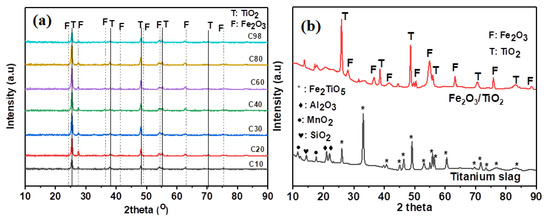
Figure 1.
XRD patterns of (a) the Fe2O3/TiO2 composites treated with various concentrations of sulfuric acid and (b) the titanium slag and the C20 sample calcined at 600 °C for 3 h.
The formation of Fe2O3/TiO2 mixed oxides was further confirmed by Fourier transform infrared attenuated total reflection (FT-IR ATR) spectroscopy as shown in Figure 2a. In the FT-IR ATR spectra of Fe2O3/TiO2 composite, the adsorption bands at 1082.38 cm−1 and 464.05 cm−1 are ascribed to the bending vibrations of O-H and stretching vibrations of metal-O (Ti-O, Fe-O) [33], respectively. The above results indicated that Fe2O3/TiO2 composites were successfully fabricated from titanium slag. Figure 2b shows the EDX spectra of the titanium slag and Fe2O3/TiO2 composite (C20 sample). The EDX analysis results indicate that the samples consist of a certain amount of Ti and Fe, in addition to elements such as Al, Mn, and Si, which are observed in the XRD patterns. One can see from Figure 2b that the element composition of the Fe2O3/TiO2 composite does not change much after sulfation and calcination, with the elemental compositions of Ti, Fe, an O in the composite being almost similar to those in the titanium slag.
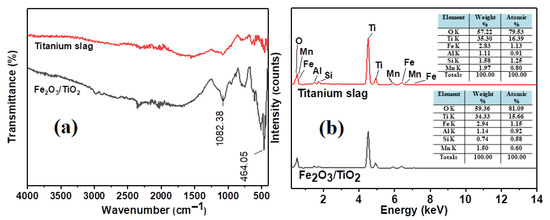
Figure 2.
(a) FT−IR ATR spectra and (b) EDX spectra of the titanium slag and the Fe2O3/TiO2 composite (C20) calcined at 600 °C for 3 h.
The surface morphology of titanium slag and Fe2O3/TiO2 composite was investigated by using scanning electron microscopy, and the result is shown in Figure 3a–c. Titanium slag is in the form of microparticles with diameters ranging from 100–400 µm (Figure 3a). After calcination and ball milling, the particle size distribution of the Fe2O3/TiO2 composite was significantly decreased to 50–500 nm (Figure 3b,c). The nitrogen adsorption–desorption isotherm and pore size distribution of the Fe2O3/TiO2 composite (C20 sample) are shown in Figure 3. According to IUPAC classifications, the adsorption isotherm displays a type IV and an H3 hysteresis loop in the relative pressure range of 0.5 to 1, which suggests that the material is mesoporous [34]. The BET surface area of the Fe2O3/TiO2 composite was determined to be 75.65 m2/g. The pore size and pore volume were calculated using the BJH method and are equal to 6.22 nm and 0.18 cm3/g, respectively.

Figure 3.
SEM images (a) titanium slag, (b,c) Fe2O3/TiO2 composite, and (d) the N2 adsorption isotherm and pore size distribution (inset) of the Fe2O3/TiO2 composite (C20).
3.2. Adsorption Study
3.2.1. Effect of Sulfuric Acid Concentration on As(V) Adsorption
The Fe2O3/TiO2 composites were prepared by treating titanium slag with sulfuric acid at various concentrations (10%, 20%, 30%, 40%, 60%, 80%, and 98%), and the samples—C10, C20, C30, C40, C60, C80, and C98, respectively—were calcinated at 600 °C in 3 h. The adsorption behavior of the samples toward As(V) was studied, as illustrated in Figure 4. It can be seen that at different sulfuric acid concentrations, the removal efficiency of As(V) did not change much and reached a higher removal efficiency of 92.8% at a sulfuric acid concentration of 20%. This result is consistent with the XRD results of Fe2O3/TiO2 composites treated with different concentrations of sulfuric acid, in which titanium slag reacted with sulfuric acid and was calcined in the air to produce Fe2O3/TiO2 composites.
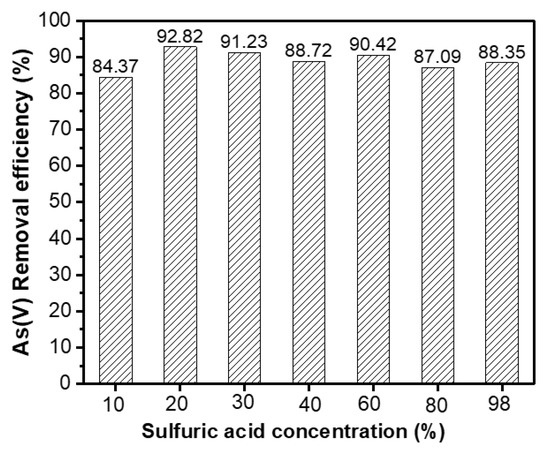
Figure 4.
Effect of sulfuric acid concentration on As(V) adsorption.
3.2.2. Effect of Calcining Time on As(V) Adsorption
Figure 5 shows the effect of the calcining time at 600 °C on the adsorption efficiency of the composite toward As(V). It can be seen from the figure that the removal percentage of As(V) increases along with the calcination time of the titanium slag. Without a calcination process with sulfuric acid, the titanium slag exhibited a removal percentage toward As(V) ions of only 7.86%. After 1 h of calcination, the As(V) adsorption was significantly increased to 51.61% and reached a maximum value of approximately 91% after 3 h of calcination. Further increase in the calcination time caused a negligible decrease in the removal percentage of As(V). Thus, a calcining time of 3 h was selected as the optimum calcination time for preparation of the Fe2O3/TiO2 composite as an adsorbent for the removal of As(V).
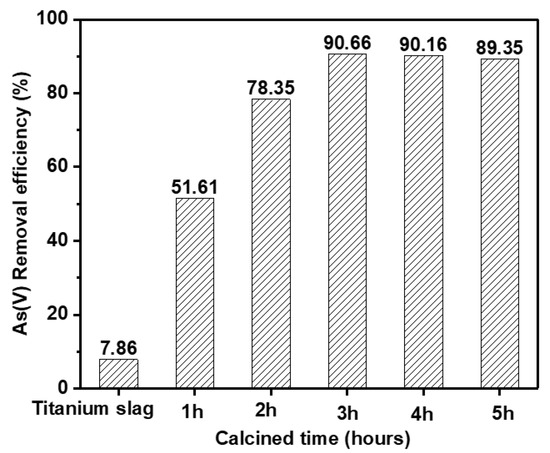
Figure 5.
Effect of the calcination time on the As(V) removal efficiency by the Fe2O3/TiO2 adsorbent.
3.2.3. Influence of pH on As(V) Adsorption
In most adsorption systems, one of the most important things that affects the surface charge of the adsorbent and the As(V) ion species in the solution is the pH of the solution. The pH point of zero charges is a very important surface characteristic of an adsorbent in explaining adsorption efficiency. Figure 6a shows a plot of the zeta potential (∆pH) of Fe2O3/TiO2 adsorbent versus the initial pH (pHi), and it was found that the pHpzc of the sorbent was about 8.45. The effect of the solution pH on the adsorption capacity of Fe2O3/TiO2 composite toward As(V) is illustrated in Figure 6b. The high adsorption capacity towards As(V) was maintained at pH values ranging from 3 to 7 but decreased at pH values ranging from 9 to 11. The increase in the adsorption capacity at pH less than 7 was caused by the point of zero charges of Fe2O3/TiO2 composite (pHpzc = 8.45) and As(V) species present in the solution. The acid ionization constants (pKa) of the oxoacids of As (V) are listed in Table 1 [35]. As(V) exists in the form of H3AsO4 at pH < 2, H2AsO4− at pH = 2–7, HAsO42− at pH = 7–11, and AsO43− at pH > 12. When the pH is increased from 3 to 7, the concentration of H2AsO4− ions present in the solution increases. H2AsO4− ions are then adsorbed by the positively charged surface of the Fe2O3/TiO2 adsorbent (pH < pHpzc) due to the attractive electrostatic forces, and as a result, the adsorption increases. At pH > pHpzc, the surface sites present on the adsorbent are negatively charged and inappropriate for the adsorption of anionic arsenate species, leading to an increase in the number of OH− ions present in the solution. They will thus be in competition with the anionic arsenate species for adsorption [36,37]. As a result, the adsorption of As(V) is decreased at pH values ranging from 9 to 11.
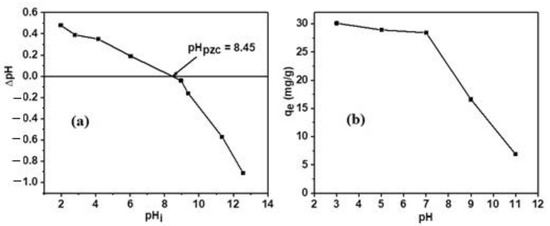
Figure 6.
(a) pH Point of zero charges (pHpzc) and (b) effect of pH on As(V) adsorption.

Table 1.
Equations and pKa values for As(V) species.
3.3. Adsorption Isotherms
The Langmuir and Freundlich models were used to describe the isotherms of As(V) adsorption on the Fe2O3/TiO2 composite. The Langmuir isotherm suggests that monolayer adsorption occurs at specific spots on the surface of the adsorbent. The linear expressions of the Langmuir isotherm are calculated as the following equation [3]:
where qe (mg/g), qm (mg/g), Ce (mg/L), and KL (L/mg) are the equilibrium adsorption capacity, the maximum adsorption capacity, the equilibrium As(V) concentration, and the Langmuir isotherm constant, respectively
The Freundlich isotherm model assumes that there is multilayer adsorption on heterogeneous sites and that the linear equation can be written as [3]:
where KF (mg/g) is the Freundlich constant and n is the heterogeneity factor. The respective slope and intercept values of the linear plot of Ce and Ce/qe and lnCe vs. lnqe were utilized to determine the isotherm parameter values, which are shown in Figure 7, and adsorption isotherm parameters are presented in Table 2.

Figure 7.
(a) Langmuir and (b) Freundlich isotherm for As(V) removal.

Table 2.
Parameters of adsorption isotherms of Fe2O3/TiO2 composite for As(V) removal.
It can be seen from Table 2 that the Freundlich model has a better fit with a regression coefficient of R2 = 0.9977 in comparison with R2 = 0.9825 for the Langmuir model. Additionally, the calculated heterogeneity factor (n = 1.185) lies within the range of 1–10 (1 < n < 10) which suggests that the Freundlich model is the more favorable model. This indicated that the adsorbent surface is not uniform and that there is multilayer adsorption. This result was consistent with the work reported by Beduk F [38], who reported that the adsorption of As(V) on Fe3O4/TiO2 was well represented by the Freundlich isotherm. According to the Langmuir model, the maximum adsorption capacity of the TiO2/Fe2O3 toward As(V) was 68.26 mg/g.
Table 3 shows the adsorption capacity of the TiO2/Fe2O3 composite prepared from titanium slag and others. It can be seen from Table 3 that the adsorption capacity of some adsorbents toward As(V) was lower than that of TiO2/Fe2O3 prepared in this work and thus can be considered a promising adsorbent for the removal of As(V) present in wastewater.

Table 3.
As(V) adsorption capacity of Fe2O3/TiO2 in comparison to various adsorbents.
3.4. Adsorption Kinetics
The adsorption kinetics can investigate the mechanism and potential rate-control steps of heavy metal adsorption on the adsorbent. The adsorption experimental data were fitted to the pseudo-first- and pseudo-second-order kinetic models. The linear form of these models is given as follows [3]:
where k1 (L/min) and k2 (mg/g·min) are the rate constants of pseudo-first-order and pseudo-second-order adsorption, respectively; qe and qt (mg/g) are the amounts of adsorption at equilibrium and at time t, respectively.
Figure 8 illustrates the linearized plots of the investigated kinetic models, and the kinetic parameters are given in Table 4. The results indicate that the As(V) adsorption onto Fe2O3/TiO2 is described by the pseudo-second-order kinetic model with R2 = 0.9991. Moreover, the qcal values of the pseudo-second-order model were found to be nearly equal to the equilibrium concentration from the experimental data of As(V) adsorption, which indicates that the As(V) adsorption process is limited by the rate-limiting step due to the interaction through exchanging or sharing of electrons between the adsorbate ions and the adsorbent [3].
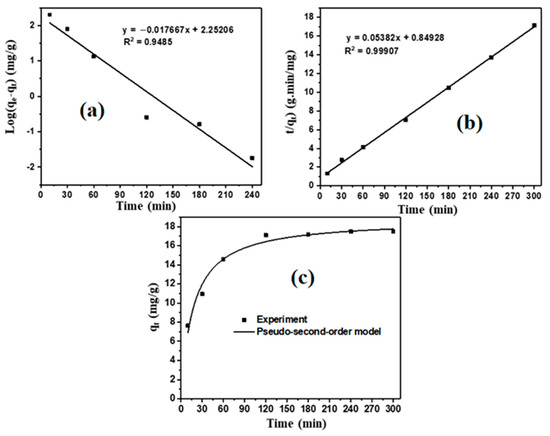
Figure 8.
(a) Pseudo−first− and (b) pseudo−second−order kinetics and (c) the experimental and calculated data from the pseudo-second-order kinetic model for the As(V) removal.

Table 4.
The kinetic parameters for As(V) adsorption onto Fe2O3/TiO2 composite.
A testing column 2 cm in diameter and 10 cm in height was utilized to study the reusability of the TiO2/Fe2O3 composite for the As(V) removal. In total, 200 mg of the composite was filled into the column. The testing process was implemented with 10 mL of 10 ppm As(V) solution at pH of 7. After the first adsorption cycles, 30 mL of a 2M NaOH solution was used to thoroughly rinse the filter column to regenerate the composite for the next recycling test. The experiment was repeated for five cycles, and the result is exhibited in Figure 9. It is obvious to conclude from Figure 9 that the TiO2/Fe2O3 composite is durable with high recyclability toward As(V) adsorption and a negligible decrease in the removal percentage (<10%) after five testing cycles—from 92% for the first cycle to 86% for the fifth cycle—implying that the TiO2/Fe2O3 composite could be employed as an effective adsorbent for the removal of As(V).
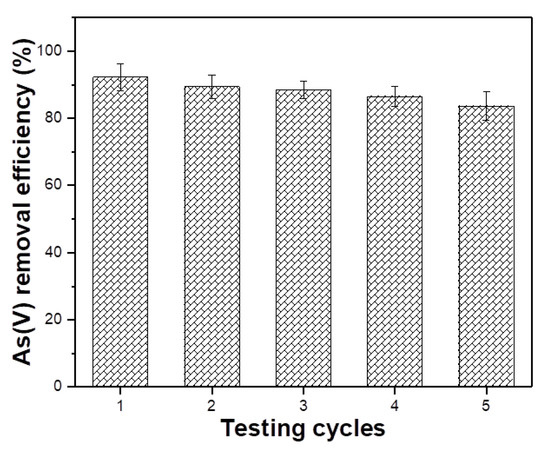
Figure 9.
Reusability of the TiO2/Fe2O3 composite for the As(V) adsorption.
With reasonable recyclability, high As(V) adsorption capacity, and low-cost and friendly fabrication process, the TiO2/Fe2O3 composite prepared from titanium slag could be obtained via the large-scale process. The small size of the TiO2/Fe2O3 composite (in range of 50–500 nm) could be overcome by the granulation process and composited with other materials (graphene, biomass and others…), to obtain large size particles for industrial applications. Thus, further studies are carried out in our group for the fabrication of the TiO2/Fe2O3 composite from titanium slag in large scale and for the evaluation of the practical use of TiO2/Fe2O3 composite.
4. Conclusions
In short, Fe2O3/TiO2 composites were successfully fabricated from titanium slag and low-concentrated sulfuric acid (20%) by using a facile one-step calcination for 3 h at 600 °C, followed by a ball-milled process for 45 min. The fabricated Fe2O3/TiO2 composites have particle sizes of 50–400 nm and a surface area of 76.65 m2/g. The adsorbent is highly effective in removing As(V) from an aqueous solution, with an adsorption capacity of 68.26 mg·g−1 at pH = 7. The obtained Fe2O3/TiO2 composites were stable and could be reused many times, which still maintained significant adsorption performance for the As(V). This technique for fabricating composites enables the reduction of the concentration of sulfuric acid, which could provide an additional benefit for the preparation of Fe2O3/TiO2 composites from raw titanium and prolong the service life of processing equipment. With high adsorption capacity and low-cost fabrication, the prepared Fe2O3/TiO2 composites are considered a promising adsorbent for the removal of highly hazardous As(V) from the water source. The fabrication of the Fe2O3/TiO2 composite from titanium slag with low acid concentration and the wide availability of industrial furnaces and millings could enable the large-scale and sustainable transformation of titanium slag into adsorbent for industrial uses.
Author Contributions
Conceptualization—H.T.T.P. and D.D.L.; methodology—C.V.T.; software C.V.T. and P.T.H.N.; investigation—C.V.T. and D.D.L.; data curation—D.D.N.; writing—original draft—C.V.T. and D.D.L.; writing—reviewing scientific contents and editing—D.D.L., D.D.N. and D.T.D. All authors have read and agreed to the published version of the manuscript.
Funding
This work was financially supported by the National Key Science and Technology Program for the innovation and modernization of mining and mineral processing technologies by 2025 under grant number ĐT.CNKK.QG.002/21.
Institutional Review Board Statement
Not applicable.
Informed Consent Statement
Not applicable.
Data Availability Statement
Not applicable.
Acknowledgments
Institute of chemistry and materials.
Conflicts of Interest
The authors declare that no conflict of interest.
References
- Kong, Q.; Shi, X.; Ma, W.; Zhang, F.; Yu, T.; Zhao, F.; Zhao, D.; Wei, C. Strategies to improve the adsorption properties of graphene-based adsorbent towards heavy metal ions and their compound pollutants: A review. J. Hazard. Mater. 2021, 415, 125690. [Google Scholar] [CrossRef]
- Akhlaghian, F.; Souri, B.; Mohamadi, Z. Nanostructured Fe2O3/Al2O3 Adsorbent for removal of As (V) from water. Adv. Environ. Technol. 2017, 3, 67–75. [Google Scholar]
- Priya, V.N.; Rajkumar, M.; Mobika, J.; Sibi, S.L. Adsorption of As (V) ions from aqueous solution by carboxymethyl cellulose incorporated layered double hydroxide/reduced graphene oxide nanocomposites: Isotherm and kinetic studies. Environ. Technol. Innov. 2022, 26, 102268. [Google Scholar] [CrossRef]
- Siddiqui, S.I.; Naushad, M.; Chaudhry, S.A. Promising prospects of nanomaterials for arsenic water remediation: A comprehensive review. Process Saf. Environ. Prot. 2019, 126, 60–97. [Google Scholar] [CrossRef]
- Senn, A.-C.; Hug, S.J.; Kaegi, R.; Hering, J.G.; Voegelin, A. Arsenate co-precipitation with Fe (II) oxidation products and retention or release during precipitate aging. Water Res. 2018, 131, 334–345. [Google Scholar] [CrossRef]
- Naushad, M.; Mittal, A.; Rathore, M.; Gupta, V. Ion-exchange kinetic studies for Cd (II), Co (II), Cu (II), and Pb (II) metal ions over a composite cation exchanger. Desalin. Water Treat. 2015, 54, 2883–2890. [Google Scholar] [CrossRef]
- Burakov, A.E.; Galunin, E.V.; Burakova, I.V.; Kucherova, A.E.; Agarwal, S.; Tkachev, A.G.; Gupta, V.K. Adsorption of heavy metals on conventional and nanostructured materials for wastewater treatment purposes: A review. Ecotoxicol. Environ. Saf. 2018, 148, 702–712. [Google Scholar] [CrossRef] [PubMed]
- Bao, S.; Yang, W.; Wang, Y.; Yu, Y.; Sun, Y.; Li, K. PEI grafted amino-functionalized graphene oxide nanosheets for ultrafast and high selectivity removal of Cr(VI) from aqueous solutions by adsorption combined with reduction: Behaviors and mechanisms. Chem. Eng. J. 2020, 399, 125762. [Google Scholar] [CrossRef]
- Fan, H.; Ma, X.; Zhou, S.; Huang, J.; Liu, Y.; Liu, Y. Highly efficient removal of heavy metal ions by carboxymethyl cellulose-immobilized Fe3O4 nanoparticles prepared via high-gravity technology. Carbohydr. Polym. 2019, 213, 39–49. [Google Scholar] [CrossRef]
- Nguyen, P.T.; Nguyen, D.A.; Nguyen, T.T.; Le, B.T.; Nguyen, P.H.T.; La, D.D. Low-cost fabrication of Fe2O3/rutile nanocomposite from Ilmenite ore: A highly effective adsorbent for removal of arsenic in aqueous media. Adv. Nat. Sci. Nanosci. Nanotechnol. 2019, 10, 015014. [Google Scholar]
- Gupta, K.; Joshi, P.; Gusain, R.; Khatri, O.P. Recent advances in adsorptive removal of heavy metal and metalloid ions by metal oxide-based nanomaterials. Coord. Chem. Rev. 2021, 445, 214100. [Google Scholar] [CrossRef]
- Nassar, N.N. Iron oxide nanoadsorbents for removal of various pollutants from wastewater: An overview. In Application of Adsorbents for Water Pollution Control; Bentham Science Publishers: Sharjah, United Arab Emirates, 2012; pp. 81–118. [Google Scholar]
- Tang, W.; Li, Q.; Gao, S.; Shang, J.K. Arsenic (III, V) removal from aqueous solution by ultrafine α-Fe2O3 nanoparticles synthesized from solvent thermal method. J. Hazard. Mater. 2011, 192, 131–138. [Google Scholar] [CrossRef] [PubMed]
- Aredes, S.; Klein, B.; Pawlik, M. The removal of arsenic from water using natural iron oxide minerals. J. Clean. Prod. 2013, 60, 71–76. [Google Scholar] [CrossRef]
- Prabhakar, R.; Samadder, S. Low cost and easy synthesis of aluminium oxide nanoparticles for arsenite removal from groundwater: A complete batch study. J. Mol. Liq. 2018, 250, 192–201. [Google Scholar] [CrossRef]
- Baranik, A.; Gagor, A.; Queralt, I.; Marguí, E.; Sitko, R.; Zawisza, B. Determination and speciation of ultratrace arsenic and chromium species using aluminium oxide supported on graphene oxide. Talanta 2018, 185, 264–274. [Google Scholar] [CrossRef]
- Feng, C.; Aldrich, C.; Eksteen, J.; Arrigan, D. Removal of arsenic from alkaline process waters of gold cyanidation by use of γ-Fe2O3@ ZrO2 nanosorbents. Hydrometallurgy 2017, 174, 71–77. [Google Scholar] [CrossRef]
- Sakthivel, T.S.; Das, S.; Pratt, C.J.; Seal, S. One-pot synthesis of a ceria-graphene oxide composite for the efficient removal of arsenic species. Nanoscale 2017, 9, 3367–3374. [Google Scholar] [CrossRef]
- Wu, K.; Jing, C.; Zhang, J.; Liu, T.; Yang, S.; Wang, W. Magnetic Fe3O4@CuO nanocomposite assembled on graphene oxide sheets for the enhanced removal of arsenic (III/V) from water. Appl. Surf. Sci. 2019, 466, 746–756. [Google Scholar] [CrossRef]
- Deedar, N.; Aslam, I. Evaluation of the adsorption potential of titanium dioxide nanoparticles for arsenic removal. J. Environ. Sci. 2009, 21, 402–408. [Google Scholar]
- Xu, Z.; Li, Q.; Gao, S.; Shang, J.K. As (III) removal by hydrous titanium dioxide prepared from one-step hydrolysis of aqueous TiCl4 solution. Water Res. 2010, 44, 5713–5721. [Google Scholar] [CrossRef]
- Bullen, J.C.; Kenney, J.P.; Fearn, S.; Kafizas, A.; Skinner, S.; Weiss, D.J. Improved accuracy in multicomponent surface complexation models using surface-sensitive analytical techniques: Adsorption of arsenic onto a TiO2/Fe2O3 multifunctional sorbent. J. Colloid Interface Sci. 2020, 580, 834–849. [Google Scholar] [CrossRef] [PubMed]
- Yu, L.; Peng, X.; Ni, F.; Li, J.; Wang, D.; Luan, Z. Arsenite removal from aqueous solutions by γ-Fe2O3-TiO2 magnetic nanoparticles through simultaneous photocatalytic oxidation and adsorption. J. Hazard. Mater. 2013, 246, 10–17. [Google Scholar] [CrossRef] [PubMed]
- Babu, C.M.; Vinodh, R.; Sundaravel, B.; Abidov, A.; Peng, M.M.; Cha, W.S.; Jang, H.-T. Characterization of reduced graphene oxide supported mesoporous Fe2O3/TiO2 nanoparticles and adsorption of As (III) and As (V) from potable water. J. Taiwan Inst. Chem. Eng. 2016, 62, 199–208. [Google Scholar] [CrossRef]
- D’Arcy, M.; Weiss, D.; Bluck, M.; Vilar, R. Adsorption kinetics, capacity and mechanism of arsenate and phosphate on a bifunctional TiO2-Fe2O3 bi-composite. J. Colloid Interface Sci. 2011, 364, 205–212. [Google Scholar] [CrossRef] [PubMed]
- Smith, Y.R.; Raj, K.J.A.; Subramanian, V.R.; Viswanathan, B. Sulfated Fe2O3-TiO2 synthesized from ilmenite ore: A visible light active photocatalyst. Colloids Surf. A Physicochem. Eng. Asp. 2010, 367, 140–147. [Google Scholar] [CrossRef]
- Anuradha, S.; Raj, K.; Vijayaraghavan, V.; Viswanathan, B. Sulphated Fe2O3-TiO2 catalysed transesterification of soybean oil to biodiesel. Indian J. Chem. 2014, 53A, 1493–1499. [Google Scholar]
- Phoohinkong, W.; Yimwan, W.; Mekprasart, W.; Pecharapa, W. Preparation of nano FeTiO3-TiO2 catalyst from ilmenite ore for catalytic degradation of methylene blue. Suranaree J. Sci. Technol. 2016, 23, 453–459. [Google Scholar]
- Zhang, L.; He, Y.; Wu, Y.; Wu, T. Photocatalytic degradation of RhB over MgFe2O4/TiO2 composite materials. Mater. Sci. Eng. B 2011, 176, 1497–1504. [Google Scholar] [CrossRef]
- Su, H.; Lv, X.; Zhang, Z.; Yu, J.; Wang, T. Arsenic removal from water by photocatalytic functional Fe2O3-TiO2 porous ceramic. J. Porous Mater. 2017, 24, 1227–1235. [Google Scholar] [CrossRef]
- Gupta, K.; Saha, S.; Ghosh, U.C. Synthesis and characterization of nanostructure hydrous iron-titanium binary mixed oxide for arsenic sorption. J. Nanopart. Res. 2008, 10, 1361–1368. [Google Scholar] [CrossRef]
- Amar, I.; Sharif, A.; Ali, M.; Alshareef, S.; Altohami, F.; Abdulqadir, M.; Ahwidi, M. Removal of methylene blue from aqueous solutions using nano-magnetic adsorbent based on zinc-doped cobalt ferrite. Chem. Methodol. 2020, 4, 1–18. [Google Scholar]
- Chen, G.; Pu, J.; Chen, J.; Peng, J.; Srinivasakannan, C.; Ruan, R. Multi-scale investigation of the formation and properties of high-grade rutile TiO2 from titanium slags using microwave heating. R. Soc. Open Sci. 2018, 5, 171858. [Google Scholar] [CrossRef] [PubMed]
- Ma, S.; Gu, J.; Han, Y.; Gao, Y.; Zong, Y.; Ye, Z.; Xue, J. Facile fabrication of C-TiO2 nanocomposites with enhanced photocatalytic activity for degradation of tetracycline. ACS Omega 2019, 4, 21063–21071. [Google Scholar] [CrossRef]
- Wilson, S.C.; Lockwood, P.V.; Ashley, P.M.; Tighe, M. The chemistry and behaviour of antimony in the soil environment with comparisons to arsenic: A critical review. Environ. Pollut. 2010, 158, 1169–1181. [Google Scholar] [CrossRef] [PubMed]
- Maghsodi, A.; Adlnasab, L. In-situ chemical deposition as a new method for the preparation of Fe3O4 nanopaeticles embedded on anodic aluminum oxide membrane (Fe3O4@ AAO): Characterization and application for arsenic removal using response surface methodology. J. Environ. Chem. Eng. 2019, 7, 103288. [Google Scholar] [CrossRef]
- Ouédraogo, I.W.; Pehlivan, E.; Tran, H.T.; Bonzi-Coulibaly, Y.L.; Zachmann, D.; Bahadir, M. Synthesis of iron oxyhydroxide-coated rice straw (IOC-RS) and its application in arsenic (V) removal from water. J. Water Health 2015, 13, 726–736. [Google Scholar] [CrossRef] [PubMed]
- Beduk, F. Superparamagnetic nanomaterial Fe3O4-TiO2 for the removal of As (V) and As (III) from aqueous solutions. Environ. Technol. 2016, 37, 1790–1801. [Google Scholar] [CrossRef]
- Ma, L.; Tu, S. Removal of arsenic from aqueous solution by two types of nano TiO2 crystals. Environ. Chem. Lett. 2011, 9, 465–472. [Google Scholar] [CrossRef]
Disclaimer/Publisher’s Note: The statements, opinions and data contained in all publications are solely those of the individual author(s) and contributor(s) and not of MDPI and/or the editor(s). MDPI and/or the editor(s) disclaim responsibility for any injury to people or property resulting from any ideas, methods, instructions or products referred to in the content. |
© 2023 by the authors. Licensee MDPI, Basel, Switzerland. This article is an open access article distributed under the terms and conditions of the Creative Commons Attribution (CC BY) license (https://creativecommons.org/licenses/by/4.0/).